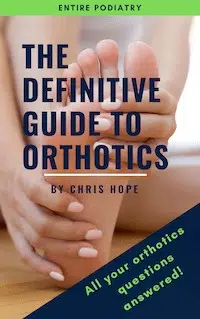What is the treatment for shin splints?
Initial treatment for shin splints is rest. If you are a runner, it is recommended that you either cease or reduce your running distance and intensity, or alternatively change your mode of exercise (for example, to cycling or deep water running). Ice and non-steroidal anti-inflammatory medication can also assist to reduce inflammation.
A biomechanical assessment by a podiatrist can assess whether your feet roll in or over-pronate, which is often a contributory factor to shin splints. To reduce over-pronation, total contact orthotics offer the most effective solution to optimise your foot function and reduce further stress on the muscles of the lower leg. Appropriate and supportive footwear is also important and a podiatrist will be able to advise on the best footwear to suit your foot type.
Some people benefit from the use of a compression sleeve worn over the calf. A compression sleeve may decrease the strain and fatigue of the lower leg muscles by providing support and stability to these muscles. Compression can also help with the circulation and venous return.
The biomechanical assessment will also determine if you have any muscular imbalances or tightness contributing to the development of your Shin Splints. You podiatrist will design specific exercises and stretches to address any muscular weaknesses or imbalances that are predisposing you to Shin Splints.
At Entire podiatry we successfully treat tight and dysfunctional muscles through the use of trigger point therapy and myofascial release. We identify tight muscles or ‘knots’ within muscles and uses pressure to ‘release’ these and improve their function.
Custom orthotics for shin splints
Foot orthotics are customised foot innersoles designed by your podiatrist to support the foot and reduce strain through the muscles in the leg. Orthotics also provide cushioning and spread the pressure out evenly across your foot to assist in shock absorption.
At Entire Podiatry we offer a range of different types of orthotics to suit different needs (Link to orthotic page).
In order to make these orthotic devices, the podiatrist will perform a thorough ‘biomechanical assessment.’ This assessment will reveal the potential causes of your Shin Splints and the orthotics will be designed in such a way to address and correct this. E.g. If your feet roll in or over-pronate, which is often a contributory factor to Shin Splints, your orthotics will be designed to reduce over-pronation to optimise your foot function and reduce further stress on the muscles of the lower leg.
Finding the correct shoe that will accommodate and compliment the orthotics will be an important discussion to be had with you and your podiatrist. Some orthotics are not suited to certain shoe types and the orthotics prescribed by your podiatrist will also vary depending on the style of shoe you intend to wear your orthotics with.
Best shoes to prevent shin splints
Footwear plays a vital role in supporting and cushioning our feet. Therefore it is no surprise that incorrect footwear is one of the leading causes of the development of Shin Splints.
When your shin splint pain is flaring up you will most likely notice that it will feel better when wearing a sneaker style shoe. This is because sports shoes tend to offer more cushioning and support compared to other types of shoes. We recommend you wear your joggers as much as you can when your shin splint pain is bad. However, we understand that joggers cannot be worn in all circumstances. This is why we recommend that you see your podiatrist to discuss other types of footwear to best prevent and treat your Shin Splints.
We understand the importance of working with you, especially when it comes to footwear. This is why we won’t tell you to wear one specific type of shoe. A common complaint from patients is that they are ‘told’ by podiatrists to wear shoes that don’t work for them or fit in with their work requirements or personal preferences. At Entire Podiatry we will advise the best types of shoes for you but also listen to you and work with your needs and preferences, after all, there’s no point in owning the ‘perfect shoes’ if you’re not going to wear them. We recommend you bring your shoes to your consult so the podiatrist can assess them.
The best running shoes for shin splints
There is no single ‘best’ running shoe for everyone. Instead, the best type of running shoe to assist with Shin Splints will depend on your specific foot type and your needs. Shoes that offer exceptional all-around support will help to prevent over-pronation and reduce strain on the muscles in the lower leg. A cushioned shoe will also assist with shock absorption.
A gait assessment by your podiatrist will reveal if you current shoes are appropriate for you and your foot type.
Which doctor to see for shin splints
As podiatrists, we are experts in dealing with lower limb pain. Your podiatrist will be able to diagnose your condition and provide treatment.
There are other health professionals who may also be involved in the treatment of your Shin Splints.
Whilst Shin Splints are usually diagnosed without the need for x-rays or ultrasound, there are certain reasons why your podiatrist may wish for you to have imaging carried out (e.g. to rule out the presence of other conditions such as a stress fracture). If this is required then you will also work with a radiologist and a radiographer who will take the x-ray or scans of your feet and interpret the findings.
You or your podiatrist may also wish to involve a physiotherapist in the treatment and management of your Shin Splints. Whilst both physiotherapists and podiatrists are experts in treating Shin Splints, sometimes both professions have a slightly different way of looking at the same problem, which is great for your treatment! If you already see a physiotherapist for another condition they will likely have a good understanding of how your body works. Let them know that you are also planning on seeing a podiatrist and they will no doubt work together in order to achieve the best outcomes for you.
How to strap/ tape for shin splints
If over-pronation (too much rolling in of the feet) is deemed to be a contributory factor to your Shin Splints then using an anti-pronatory strapping technique can be helpful. Your podiatrist is able to strap your feet and legs and demonstrate the technique so you can apply this yourself.
Kinesiology taping is another taping method that can be useful in the management of Shin Splints. This tape is made from a more elasticised material that can be applied to the shins to support the tissues while they heal.





